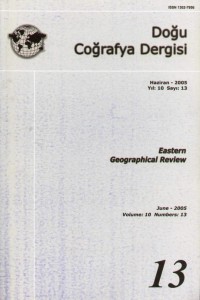Abstract
Hayat boyu öğrenme modellemesinde
coğrafyanın anahtar olduğunu savunan bu çalışma,
elimizdeki okul programlarını standartlar bakımından
birkaç ülkeyle karşılaştırıp tartışmayı amaçlamıştır.
Karşılaştırma yapılan ABD, İngiltere ve Avustralya
gibi ülkelerdeki coğrafya öğretiminde, 18 standardın
tanımlarının yanı sıra, standartlar arasındaki
bağlantıların olması ve bütünlük dikkat çekicidir.
Türkiye‟de uygulanan coğrafya öğretiminin iskeletini
oluşturan 11 yıllık programda ise standartlar net
değildir. Dünya, bölge, Türkiye konuları arasında
kıtalar-okyanuslar ölçeğindeki kategoriler atlanmıştır.
Özellikle Matematik-Fen sınıflarından mezun olan lise
öğrencilerinin coğrafya dersi açığının fazla olduğunu
söylemek mümkündür. İlk ve ortaöğretimdeki
coğrafya öğrenme kategorilerine çerçevesinde
standartların belirlenmesi gereği üzerine odaklanmış
olan bu çalışmada mevcut müfredatın bunu
sağlamaktan uzak olduğu sonucuna ulaşılmıştır.
References
- A PATH TOWARD WORLD LİTERACY, 2000, A Standards-Based Guide to K-12 Geography, National Geographic Society; (Washington, D.C., National Geographic Society,).
- ARI, Y. 2002, Amerika Birleşik Devletlerinde Coğrafya eğitimi Reformu: Türkiye İçin Dersler. Türk Coğrafya Kurumu Coğrafya Kurultayı Bildiriler Kitabı, s. 140-147. 9-12 Temmuz 2002. Ankara.
- BAYKAL, A., 1998. “Sekiz Yıl Kesintisiz ve Kesirsiz Eğitim”. TÜSİAD Görüş Dergisi, Temmuz-Ağustos, İstanbul. (http://www.tusiad.org.tr/yayin/gorus/36/html/sec8.html)
- BEDNARZ W.S., 2003, Nine Years On: Examining Implementation of The National Geography Standards. The Journal of Geography Vol. 102, 3 s.103. BİDDLE,D., 1999, Geography in Shchool, Australian Geographer, Vol. 30, Iss. 1; p. 76, .
- BİRKENHAUER, S., 2002, Proposals for a Geography Curriculum „2000+‟ for Germany, International Research in Geographical and Environmental Education, Vol.11, No.3.
- CLARK G.- HİGGİTT M, 1997, Geography and lifelong learning: A report on a survey of geography graduates, Journal of Geography in Higher Education; Jul 1997; 21, 2; Academic Research Library pg. 199.
- GEOGRAPHY EDUCATİON STANDARDS PROJECT (GESP) 1994, Geography for life: National Geography Standards 1994, National Geographic Research and Exploration, Washington D.C.
- GRİTZNER, C.F., 2003, Why geography? The Journal of Geography; Mar/Apr 2003; 102, 2; Wilson Education Abstracts pg. 90
- HİLL A. D- SOLEM, M.N., 1999, Geography on the Web: Changing the learning paradigm? The Journal of Geography; May/Jun 1999; 98, 3; Wilson Education Abstracts pg. 100
- SCHOENFETDT, M., 2001, Geography literacy and Young learners. The Education Forum. V.66 s.28.
- SEMPLE, S.,2001, Canadian National Standards for Geography: A Standards-Based Guide to K-12 Geography,The Royal Canadian Geographical Society, Sackville, New Brunswick
- ŞAHİN, C., 2003, Coğrafyaya Giriş, Gündüz eğitim ve yayıncılık, Genişletilmiş 2. Baskı, s.136, Ankara
Abstract
References
- A PATH TOWARD WORLD LİTERACY, 2000, A Standards-Based Guide to K-12 Geography, National Geographic Society; (Washington, D.C., National Geographic Society,).
- ARI, Y. 2002, Amerika Birleşik Devletlerinde Coğrafya eğitimi Reformu: Türkiye İçin Dersler. Türk Coğrafya Kurumu Coğrafya Kurultayı Bildiriler Kitabı, s. 140-147. 9-12 Temmuz 2002. Ankara.
- BAYKAL, A., 1998. “Sekiz Yıl Kesintisiz ve Kesirsiz Eğitim”. TÜSİAD Görüş Dergisi, Temmuz-Ağustos, İstanbul. (http://www.tusiad.org.tr/yayin/gorus/36/html/sec8.html)
- BEDNARZ W.S., 2003, Nine Years On: Examining Implementation of The National Geography Standards. The Journal of Geography Vol. 102, 3 s.103. BİDDLE,D., 1999, Geography in Shchool, Australian Geographer, Vol. 30, Iss. 1; p. 76, .
- BİRKENHAUER, S., 2002, Proposals for a Geography Curriculum „2000+‟ for Germany, International Research in Geographical and Environmental Education, Vol.11, No.3.
- CLARK G.- HİGGİTT M, 1997, Geography and lifelong learning: A report on a survey of geography graduates, Journal of Geography in Higher Education; Jul 1997; 21, 2; Academic Research Library pg. 199.
- GEOGRAPHY EDUCATİON STANDARDS PROJECT (GESP) 1994, Geography for life: National Geography Standards 1994, National Geographic Research and Exploration, Washington D.C.
- GRİTZNER, C.F., 2003, Why geography? The Journal of Geography; Mar/Apr 2003; 102, 2; Wilson Education Abstracts pg. 90
- HİLL A. D- SOLEM, M.N., 1999, Geography on the Web: Changing the learning paradigm? The Journal of Geography; May/Jun 1999; 98, 3; Wilson Education Abstracts pg. 100
- SCHOENFETDT, M., 2001, Geography literacy and Young learners. The Education Forum. V.66 s.28.
- SEMPLE, S.,2001, Canadian National Standards for Geography: A Standards-Based Guide to K-12 Geography,The Royal Canadian Geographical Society, Sackville, New Brunswick
- ŞAHİN, C., 2003, Coğrafyaya Giriş, Gündüz eğitim ve yayıncılık, Genişletilmiş 2. Baskı, s.136, Ankara
Details
| Primary Language | tr;en |
|---|---|
| Journal Section | RESEARCH ARTICLES |
| Authors | |
| Publication Date | March 24, 2011 |
| Submission Date | March 24, 2011 |
| Published in Issue | Year 2005 Volume: 10 Issue: 13 |
Content of this journal is licensed under a Creative Commons Attribution NonCommercial 4.0 International License


